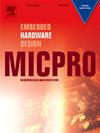高吞吐量事件过滤:基于插值的DIF算法硬件架构
IF 2.6
4区 计算机科学
Q3 COMPUTER SCIENCE, HARDWARE & ARCHITECTURE
引用次数: 0
摘要
近年来,事件视觉领域得到了迅速发展。它既体现在技术方面,随着越来越好的事件传感器的出现,也体现在算法方面,随着越来越多的技术应用的提出和科学论文的发表。然而,来自这些传感器的数据流通常包含大量的噪声,这取决于诸如观察场景中的照明程度或传感器的温度等因素。我们提出了一种基于距离的频率权重插值(DIF)滤波器的硬件架构,并在FPGA上实现。为了评估算法并将其与其他解决方案进行比较,我们准备了一个新的高分辨率事件数据集,我们也向社区发布了该数据集。我们的架构在传感器分辨率为1280 × 720时实现了每秒40339万事件(MEPS)的吞吐量,在分辨率为640 × 480时实现了428.45 MEPS。接收器工作特性下面积(AUROC)指数的平均值从0.844到0.999不等,具体取决于数据集,这与最先进的滤波解决方案相当,但在大范围的噪声水平下具有更高的吞吐量和更好的操作。本文章由计算机程序翻译,如有差异,请以英文原文为准。

High throughput event filtering: The interpolation-based DIF algorithm hardware architecture
In recent years, there has been rapid development in the field of event vision. It manifests itself both on the technical side, as better and better event sensors are available, and on the algorithmic side, as more and more applications of this technology are proposed and scientific papers are published. However, the data stream from these sensors typically contains a significant amount of noise, which varies depending on factors such as the degree of illumination in the observed scene or the temperature of the sensor. We propose a hardware architecture of the Distance-based Interpolation with Frequency Weights(DIF) filter and implement it on an FPGA chip. To evaluate the algorithm and compare it with other solutions, we have prepared a new high-resolution event dataset, which we are also releasing to the community. Our architecture achieved a throughput of 403.39 million events per second (MEPS) for a sensor resolution of 1280 × 720 and 428.45 MEPS for a resolution of 640 × 480. The averagevalues of the Area Under the Receiver Operating Characteristic (AUROC) index ranged from 0.844 to 0.999, depending on the dataset, which is comparable to the state-of-the-art filtering solutions, but with much higher throughput and better operation over a wide range of noise levels.
求助全文
通过发布文献求助,成功后即可免费获取论文全文。
去求助
来源期刊

Microprocessors and Microsystems
工程技术-工程:电子与电气
CiteScore
6.90
自引率
3.80%
发文量
204
审稿时长
172 days
期刊介绍:
Microprocessors and Microsystems: Embedded Hardware Design (MICPRO) is a journal covering all design and architectural aspects related to embedded systems hardware. This includes different embedded system hardware platforms ranging from custom hardware via reconfigurable systems and application specific processors to general purpose embedded processors. Special emphasis is put on novel complex embedded architectures, such as systems on chip (SoC), systems on a programmable/reconfigurable chip (SoPC) and multi-processor systems on a chip (MPSoC), as well as, their memory and communication methods and structures, such as network-on-chip (NoC).
Design automation of such systems including methodologies, techniques, flows and tools for their design, as well as, novel designs of hardware components fall within the scope of this journal. Novel cyber-physical applications that use embedded systems are also central in this journal. While software is not in the main focus of this journal, methods of hardware/software co-design, as well as, application restructuring and mapping to embedded hardware platforms, that consider interplay between software and hardware components with emphasis on hardware, are also in the journal scope.
 求助内容:
求助内容: 应助结果提醒方式:
应助结果提醒方式:


